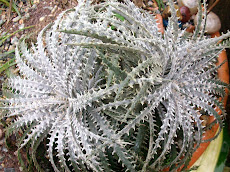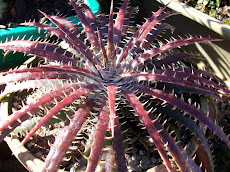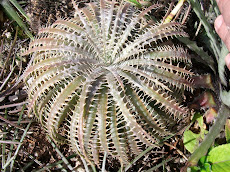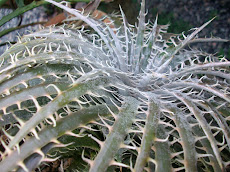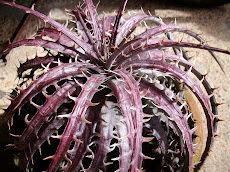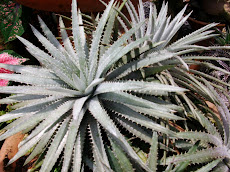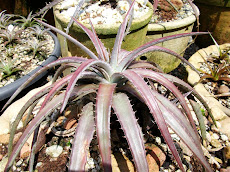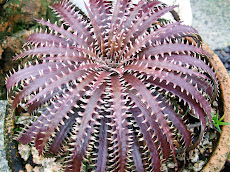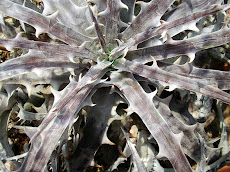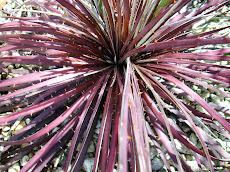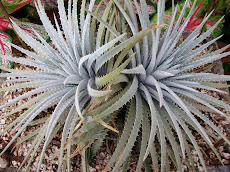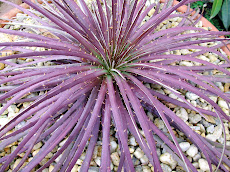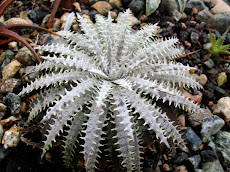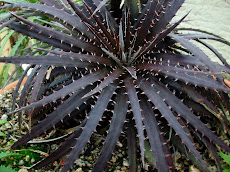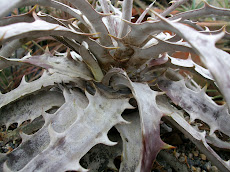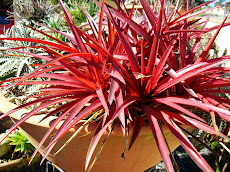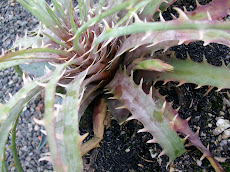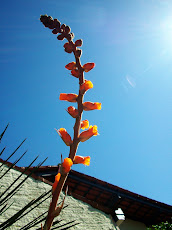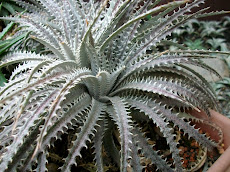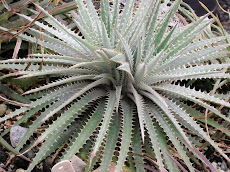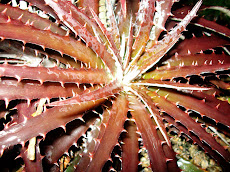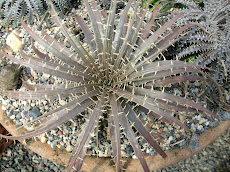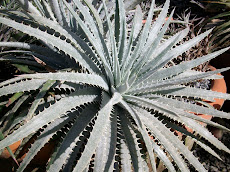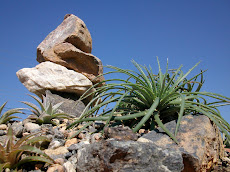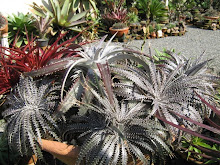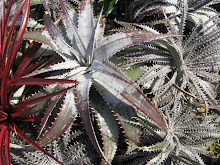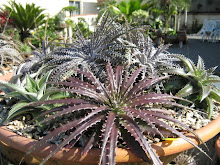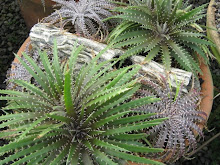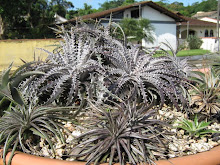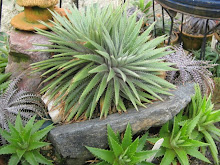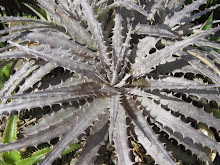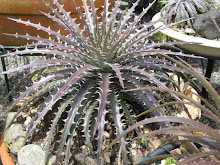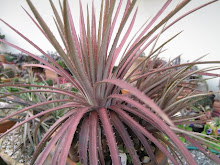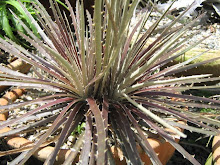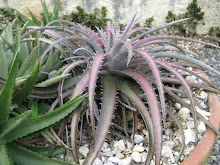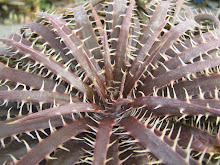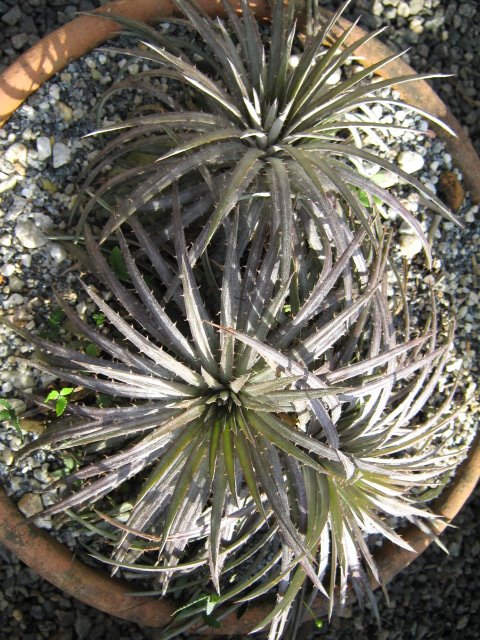Mar 28, 2014
What a honor to me!
This short article was just published and it honors me and moves me the much.
San Fernando Valley Bromeliad Society in Encino California.
San Fernando Valley Bromeliad Society in Encino California.
Bill Baker and Bill Paylen were members themselves.
Thanks to all and specially to Michael Wisney.
I am delighted.
Thanks to all and specially to Michael Wisney.
I am delighted.
Mar 26, 2014
Dyckia macedoi, super special clone
Native to Minas Gerais in Brazil this plant was found within an old cemetery.
A special clone no doubt.
A special clone no doubt.
Macedoi is a dwarf Dyckia and a living jewel.
Mar 25, 2014
Dyckia estevesii
Allow them to be natural.....In nature they are not uprighted.
Let them lay flat down to their side and flower stalks will emerge in 90 degrees.
Mar 24, 2014
dyckia reitzii rubra Aparados
Some Dyckias are so beautiful, rare, unique they are more than just spectacular.
They are dream plants.
They are dream plants.
Mar 22, 2014
Dr. Jones Caldas (Dyckia jonesiana)
Sit here by his trophy, his smile and his dogs.
Here we have a man of honor, a rarity. He is the one rare and hard to find being on this picture.
This
plant , a Dyckia maritima affinis found by Professor Leopoldo Witeck
Neto (Universidade Federal de Santa Maria-RS) in Santa Maria, Rio Grande
do Sul, nearby wilderness (Caçapava-RS).
This plant was shown and some publications told its history.
The novelty is:
Professor Witeck gave the plant to my friend Dr. Jones Caldas (Dyckia jonesiana) who lives in Porto Alegre here South in Brazil.
Dr. Jonas is a physician and a botanist who was friend of Pe. Raulino Reitz.
This plant is not a variegated one but a chimera! It presents variegation on one side and extreme yellow xantochromic leaves in the opposite one. The offsets will be stunning! We shall have all sort of dreamy plants as pure variegated ones, pure xantochronic ones and more.
This guy here shown is my friend Dr. Jones Caldas.
These pictures were taken under my request by my friend Dennis Cathcart from Tropiflora who just left Brazil this week.
Dyckias may unite friends and people and make living worthwhile and pleasurable.
This plant was shown and some publications told its history.
The novelty is:
Professor Witeck gave the plant to my friend Dr. Jones Caldas (Dyckia jonesiana) who lives in Porto Alegre here South in Brazil.
Dr. Jonas is a physician and a botanist who was friend of Pe. Raulino Reitz.
This plant is not a variegated one but a chimera! It presents variegation on one side and extreme yellow xantochromic leaves in the opposite one. The offsets will be stunning! We shall have all sort of dreamy plants as pure variegated ones, pure xantochronic ones and more.
This guy here shown is my friend Dr. Jones Caldas.
These pictures were taken under my request by my friend Dennis Cathcart from Tropiflora who just left Brazil this week.
Dyckias may unite friends and people and make living worthwhile and pleasurable.
Mar 20, 2014
UNDERSTANDING DYCKIAS
Brazil holds lots of fantastic looking plants and many just seen by a very few
eyes, others yet to be seen by the very first time.
In the Amazon we find never seen before human beings! This alone makes us think about the vastness of the Brazilian territory.
We have no deserts, no ice fields, no ultra high mountains, simply every square kilometer here is perfectly habitable any time of the year.
Presently we are finding new mammals and never once met tribe men,let aside plants and this is 2014 not 1814!
Bromeliads just recently took our eyes and Dyckias and allies are a most recent curiosity.
Science relied on collectors and bush men and our Dyckias were the last to call any attention.
Orchids and cacti were the prime "beef" to science and most of the scientists never left Europe or US offices and their homes.
Some Brazilian plants were described as being Mexican so big and confused were the collectors luggage. Most scientists were much more interested in their mentors and their own celebrity than any plant.
Dyckia dawsoni and fosteriana (type) were simply extinguished from nature in order to forbid any other "scientific" eyes to see them in nature.
Now real plant lovers are doing a good job in order to make these wonderful plants to be known.
Another point:
Most of us believe or were induced to believe a Dyckia species present the very very same look year around and all the time and all its members are the very same looking.
This is not just a mistake but an error!
Some species present just one pattern, one look but the huge and vast majority is not so.
Individuals can be smaller, bigger, whiter, darker, paler, reddisher, greener, than others. Some can bend more, some can arch their leaves more than others and present narrower and thicker leaves or bigger spines and so on and on.
Dyckias are able and prune to make any speed horseman fall from his horseback.
Why?
Because Dyckias are plants undergoing a final transformation, a last play, they present all their cards on the table... They are disappearing and naturally being eliminated from the face of the planet. Their role in nature is finished, it is done and over.
Long ago we had fields of Dyckias everywhere in here. We had no grass fields but Dyckia ones. Mountains were formed carrying Dyckias with them, lifting them up. Dyckias were not born up the hills and mountains! Mountains were formed after them! They are there for they are Sun lovers and up the hills, on rocks and close by the sea are the only sunny resorts to them. The only sunny ones.
Dyckias are among the very first plants to appear and make soil to bushes and trees. They are colonizer plants.
We know almost nothing about Dyckias and their history on Earth.
We are just beginning to unfold their mystery. Here in Brazil we have a very few brilliantly minded botanists who study and search this matter and soon brand new discoveries will be shown.
In the Amazon we find never seen before human beings! This alone makes us think about the vastness of the Brazilian territory.
We have no deserts, no ice fields, no ultra high mountains, simply every square kilometer here is perfectly habitable any time of the year.
Presently we are finding new mammals and never once met tribe men,let aside plants and this is 2014 not 1814!
Bromeliads just recently took our eyes and Dyckias and allies are a most recent curiosity.
Science relied on collectors and bush men and our Dyckias were the last to call any attention.
Orchids and cacti were the prime "beef" to science and most of the scientists never left Europe or US offices and their homes.
Some Brazilian plants were described as being Mexican so big and confused were the collectors luggage. Most scientists were much more interested in their mentors and their own celebrity than any plant.
Dyckia dawsoni and fosteriana (type) were simply extinguished from nature in order to forbid any other "scientific" eyes to see them in nature.
Now real plant lovers are doing a good job in order to make these wonderful plants to be known.
Another point:
Most of us believe or were induced to believe a Dyckia species present the very very same look year around and all the time and all its members are the very same looking.
This is not just a mistake but an error!
Some species present just one pattern, one look but the huge and vast majority is not so.
Individuals can be smaller, bigger, whiter, darker, paler, reddisher, greener, than others. Some can bend more, some can arch their leaves more than others and present narrower and thicker leaves or bigger spines and so on and on.
Dyckias are able and prune to make any speed horseman fall from his horseback.
Why?
Because Dyckias are plants undergoing a final transformation, a last play, they present all their cards on the table... They are disappearing and naturally being eliminated from the face of the planet. Their role in nature is finished, it is done and over.
Long ago we had fields of Dyckias everywhere in here. We had no grass fields but Dyckia ones. Mountains were formed carrying Dyckias with them, lifting them up. Dyckias were not born up the hills and mountains! Mountains were formed after them! They are there for they are Sun lovers and up the hills, on rocks and close by the sea are the only sunny resorts to them. The only sunny ones.
Dyckias are among the very first plants to appear and make soil to bushes and trees. They are colonizer plants.
We know almost nothing about Dyckias and their history on Earth.
We are just beginning to unfold their mystery. Here in Brazil we have a very few brilliantly minded botanists who study and search this matter and soon brand new discoveries will be shown.
Constantino Gastaldi March 2014 - Joinville Santa Catarina- Brazil
Dyckia Arco-íris (rainbow) is a Dyckia hebdingii chimera
It was found in nature by Djenes Dalfovo and me when it was a tiny seedling,
Dyckia arco-íris is an unique and an only one.
Now look closely here.....
The plant was induced to sprout and see what is coming out from the basal foliar nodules.
These are promisses of sure beautiful plants.
Mar 18, 2014
Dyckia riosulensis
Dyckia riosulensis is still to be described.
This is Dennis Cathcart from Tropiflora.
His kindness and knowledge are many, many folds his own size.
His kindness and knowledge are many, many folds his own size.
Here Dennis and Djenes passing from one pic to the other.
This is the Three Pics Mountain in Serra do Taboão, Rio do Sul , Santa Catarina.
This is the Three Pics Mountain in Serra do Taboão, Rio do Sul , Santa Catarina.
Breathtaking beautiful.
The sunny day was perfect. A gift to us all.
The sunny day was perfect. A gift to us all.
Subscribe to:
Comments (Atom)


























































